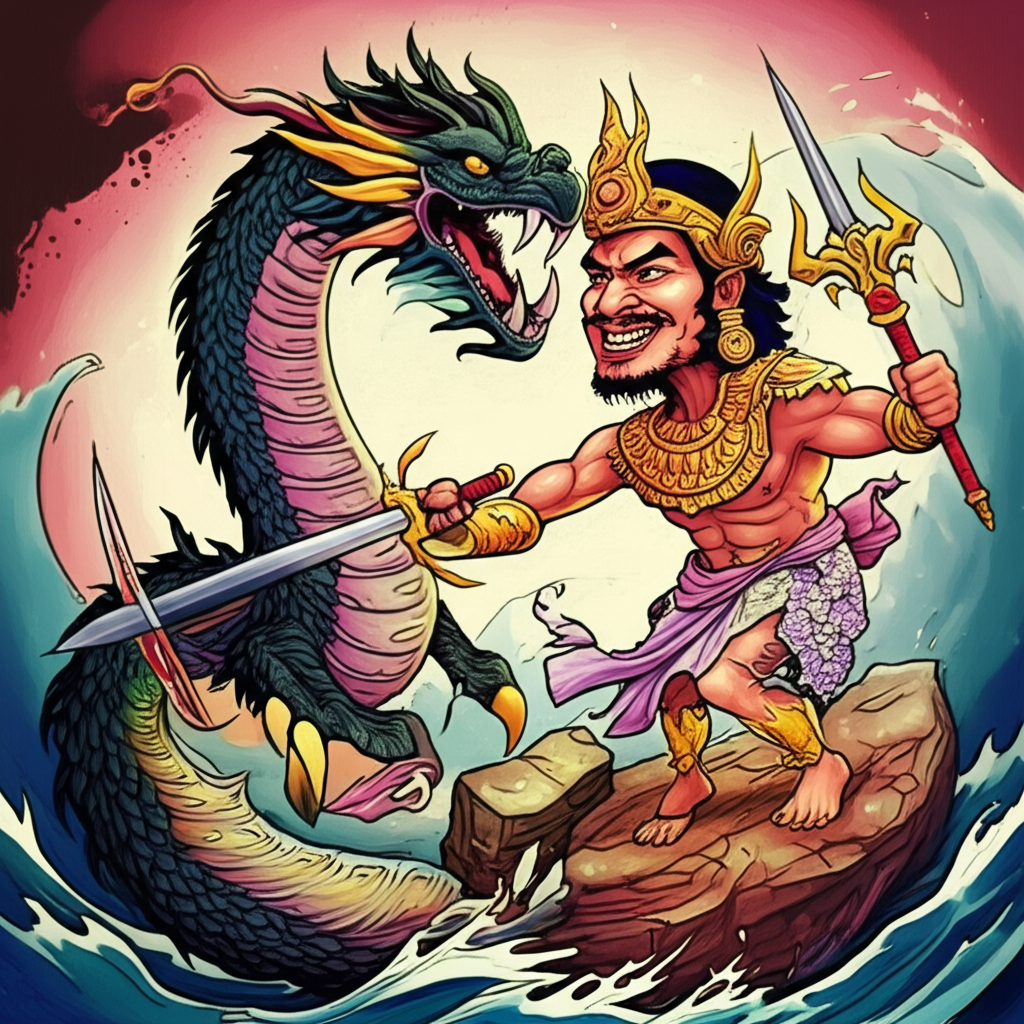
In the sun-drenched archipelagos of Southeast Asia, particularly within the rich tapestry of Filipino folklore, ancient stories were woven to explain the mysteries of the cosmos and the rhythms of life. Among these captivating narratives is the legend of Amanikable and the celestial struggle between Bakunawa, the great sea serpent, and the Moon. These tales, passed down through generations, were not intended as literal dogma but as profound expressions of a people’s understanding of their world, their fears, and their aspirations.
Origins and Cultural Background: Whispers of the Sea and Sky
The myth of Amanikable and the War of Bakunawa and the Moon likely emerged from a time when human understanding of celestial events was deeply intertwined with their daily lives. Imagine communities living in close proximity to the vast, often unpredictable ocean. Their livelihoods depended on its bounty, yet its depths held unknown terrors and its storms could devastate their shores. The sky, too, was a source of wonder and apprehension, with the changing phases of the moon dictating tides, hunting seasons, and perhaps even influencing the moods of the sea.
In these ancient societies, the world was often perceived as a realm animated by powerful, often unseen forces. Spirits inhabited the natural world – the rustling leaves, the crashing waves, the distant stars. These beings, though not worshipped as divine in the Abrahamic sense, were respected and acknowledged through rituals and stories, aiming to maintain a harmonious relationship with the environment. The celestial bodies, particularly the moon, held significant cultural weight. Its cyclical nature mirrored life, death, and rebirth, and its light illuminated the darkness, offering both guidance and a sense of vulnerability.
Character/Creature Description: Amanikable, the Sea’s Guardian, and Bakunawa, the Cosmic Dragon
Amanikable, in some interpretations, is depicted as a powerful deity or spirit of the sea, a benevolent protector who watches over its creatures and the coastal communities. He is often envisioned as a being of immense strength and wisdom, deeply connected to the ebb and flow of the ocean. His presence is felt in the calm of a sheltered cove or the surge of a powerful wave, a constant, if not always visible, force.
Bakunawa, on the other hand, is a creature of immense, primordial power, often described as a colossal serpent or dragon. Its scales are said to shimmer with an otherworldly luminescence, and its body is vast enough to encircle the world. Bakunawa is not inherently evil, but rather a force of nature, a cosmic being driven by an insatiable hunger. Its most defining characteristic in this myth is its perceived desire to consume the Moon. This hunger is not born of malice, but of a fundamental, primal urge, much like the natural forces that shape the physical world. Bakunawa represents the untamed, the chaotic, and the primal hunger that exists in both the natural and perhaps even the human psyche.
Main Story/Narrative Retelling: The Celestial Feast and the Serpent’s Grasp
The story unfolds in the ancient times, when the sky was a stage for grand cosmic dramas. The Moon, a radiant orb of silver light, sailed serenely across the inky canvas of the night. Its gentle glow guided fishermen and bathed the world in a tranquil luminescence. But lurking in the unfathomable depths of the ocean was Bakunawa, the magnificent, serpentine dragon.
Bakunawa, driven by an ancient and unending hunger, would gaze longingly at the luminous Moon. It was a light so captivating, so unlike the dark, watery abyss it called home, that the serpent yearned to taste its brilliance. And so, on nights when the Moon was full and its light seemed most inviting, Bakunawa would stir from its slumber.
With a mighty heave of its colossal body, the serpent would rise from the ocean’s embrace, its scales catching the starlight like a million scattered gems. It would ascend, a dark silhouette against the heavens, its eyes fixed on its celestial prize. As it drew closer, a palpable tension would grip the night. The tides would churn erratically, and the winds would whisper with an anxious urgency.
The ancient peoples, witnessing this spectacle, would cry out in alarm. They believed Bakunawa was attempting to devour the Moon, to plunge their world into eternal darkness. In their desperation, they would bang pots and pans, shout and make a cacophony of noise, hoping to startle the monstrous serpent and drive it away. This clamor was not a plea to a deity, but an attempt to influence the natural order through shared action and the belief that their collective voice could affect the outcome.
It was during these moments of celestial peril that Amanikable, the guardian of the sea, would be called upon. Though his presence might not be explicitly depicted as battling Bakunawa directly, his dominion over the waters was seen as a crucial element in repelling the serpent. Some versions suggest Amanikable would summon the mightiest currents, creating whirlpools and treacherous waves that would impede Bakunawa’s ascent. Others imagine him as a silent force, his protective aura extending to the Moon, creating a subtle resistance against the serpent’s grasp. The people’s belief in Amanikable’s protective role provided a sense of hope and agency in the face of an awe-inspiring, potentially destructive event.
The struggle would continue, a silent war waged between the insatiable hunger of the serpent and the enduring light of the Moon, aided by the unseen forces of the sea. Often, Bakunawa would be thwarted, its hunger temporarily sated or its path obstructed, and it would retreat back into the ocean’s embrace, leaving the Moon to shine once more. The people would rejoice, their anxieties easing as the familiar glow returned, and they would offer thanks for the return of balance, acknowledging the unseen powers that had intervened.
Symbolism and Meaning: Echoes of Nature and Human Experience
The War of Bakunawa and the Moon served as a potent metaphor for the ancient Filipinos. Bakunawa’s hunger for the Moon could symbolize the primal, often destructive forces of nature – the destructive power of storms, the unpredictable nature of the sea, and the fear of the unknown that lurked in the darkness. The Moon, in contrast, represented order, light, knowledge, and the cyclical nature of life. Its consumption by Bakunawa would signify a disruption of this order, a descent into chaos.
Amanikable’s role, as a protector, could represent the inherent desire for order and safety within a community. His connection to the sea might also reflect the deep respect and reliance ancient peoples had on the ocean, acknowledging its dual nature of sustenance and danger. The collective action of the people, their noise-making, could symbolize the power of community and shared intention in facing adversity, even when the outcome was uncertain.
This myth also speaks to the human fascination with celestial phenomena. Eclipses, a likely inspiration for this story, were viewed with a mixture of awe and fear across many cultures. The idea of a great serpent devouring the sun or moon is a recurring motif, reflecting a universal human attempt to comprehend and explain these dramatic celestial events.
Modern Perspective: From Folklore to Cultural Tapestry
Today, the legend of Bakunawa and the Moon, and by extension Amanikable, lives on not as a literal account but as a cherished piece of cultural heritage. It finds expression in various forms of modern media. In literature, it serves as inspiration for fantasy novels and epic poems that explore themes of cosmic battles and mythical creatures. Filipino artists draw upon these tales for their paintings and sculptures, breathing new life into ancient imagery.
In popular culture, Bakunawa has become a recognizable figure in video games, often depicted as a formidable boss or a mythical beast. Its image is incorporated into festivals and cultural celebrations, reminding younger generations of their rich storytelling traditions. These interpretations allow the myth to transcend its original context, adapting and evolving while retaining its essence as a powerful narrative that speaks to the human condition.
Conclusion: A Legacy of Imagination
The story of Amanikable and the War of Bakunawa and the Moon is a testament to the enduring power of human imagination and the vital role of storytelling in shaping cultural identity. It is a tradition born from a deep connection to the natural world, an attempt to understand the celestial ballet and the profound forces that govern existence.
As Muslims, we understand that all creation, from the smallest grain of sand to the grandest celestial bodies, originates from and is sustained by Allah, the One True Creator. These ancient myths, while culturally significant, are not to be equated with divine truth. Instead, we can appreciate them as windows into the historical and cultural landscapes of our ancestors, recognizing the universal human impulse to seek meaning, to explain the inexplicable, and to find comfort and hope in the face of the unknown. These stories, in their imaginative scope and their echoes of human experience, remain a vibrant part of our collective cultural heritage, a reminder of the rich tapestry of human thought and the enduring allure of a well-told tale.





